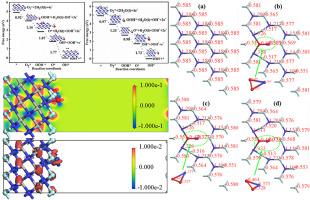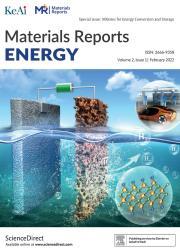二维Ti3C2Tx作为混合电解质锂-空气电池的高效阴极电催化剂
IF 13.8
引用次数: 0
摘要
混合电解质锂空气电池(HELABs)面临着阴极高过电位、循环不稳定性和催化剂降解等挑战,限制了其在实际应用中的广泛应用。本研究采用密度泛函理论(DFT)分析了二维Ti3C2Tx作为阴极催化剂的氧还原反应(ORR)自由能谱、过电位和吸附能。确定了Ti3C2Tx表面的最佳氧吸附位点,定量分析了氧吸附后的电荷转移、能带结构、态密度和成键特性。结果表明,作为HELAB阴极电催化剂,Ti3C2Tx表现出较低的过电位,氧优先吸附在Ti3C2和Ti3C2F2的顶部和桥位。这些发现为MXenes在HELABs中的应用提供了有价值的见解。本文章由计算机程序翻译,如有差异,请以英文原文为准。

2D Ti3C2Tx as efficient cathode electrocatalyst for hybrid electrolyte Li-air battery
Hybrid electrolyte lithium-air batteries (HELABs) face challenges such as the high cathode overpotential, cycling instability, and catalyst degradation, limiting their widespread use in practical applications. This study employs density functional theory (DFT) to analyze the oxygen reduction reaction (ORR) free energy profile, overpotential, and adsorption energy of two-dimensional Ti3C2Tx as a cathode catalyst. The optimal oxygen adsorption sites on Ti3C2Tx surfaces are identified, and the charge transfer, band structure, density of states, and bonding characteristics after oxygen adsorption are quantitatively analyzed. Results suggest that Ti3C2Tx exhibits low overpotentials when used as a HELAB cathode electrocatalyst, with oxygen preferentially adsorbing at the top and bridge sites of Ti3C2 and Ti3C2F2, respectively. These findings offer valuable insights for the application of MXenes in HELABs.
求助全文
通过发布文献求助,成功后即可免费获取论文全文。
去求助
来源期刊

材料导报:能源(英文)
Renewable Energy, Sustainability and the Environment, Nanotechnology
CiteScore
13.00
自引率
0.00%
发文量
0
审稿时长
50 days
 求助内容:
求助内容: 应助结果提醒方式:
应助结果提醒方式:


